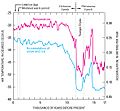Younger Dryas facts for kids

The Younger Dryas (around 12,900 to 11,700 years ago) was a cold period. It reversed the gradual climatic warming which started around 20,000 years ago.
At this time there was a sharp fall in temperature over most of the Northern Hemisphere. This occurred at the end of the Pleistocene epoch and just before the present, warmer, Holocene epoch.
The last glacial maximum (LGM) was about 27,000 to 24,000 years ago. The Younger Dryas was the most recent and longest of several interruptions to the gradual warming of the Earth's climate. The change was relatively sudden, and it resulted in a decline of temperatures in Greenland by 4 to 10 °C (7.2 to 18 °F) Glaciers and dry conditions spread over much of the temperate Northern Hemisphere. It may have been caused by an influx of fresh, cold water from North America to the Atlantic.
The Younger Dryas was a period of climatic change. The effects were complex and variable. In the Southern Hemisphere and some areas of the Northern Hemisphere, such as southeastern North America, a slight warming occurred.
Images for kids
See also
 In Spanish: Dryas Reciente para niños
In Spanish: Dryas Reciente para niños



